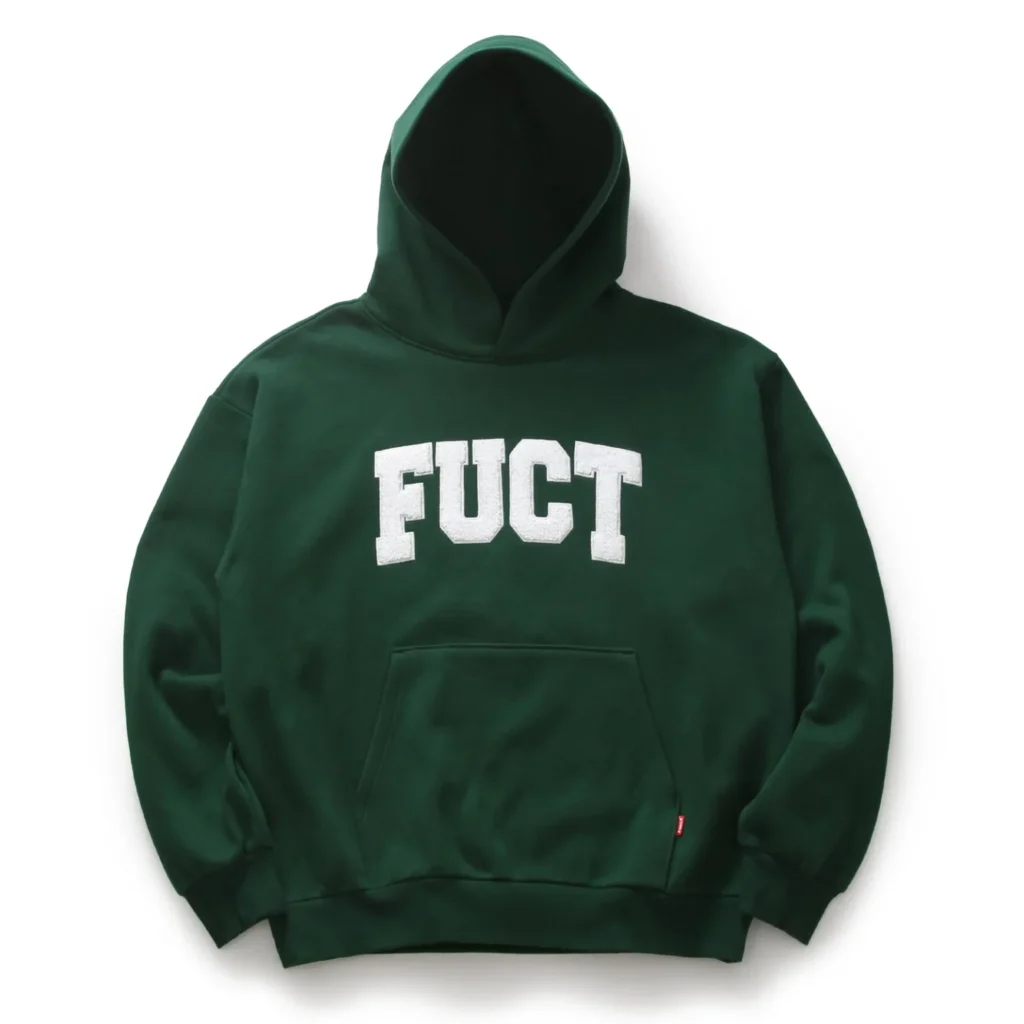Introduction
Fuct, an iconic brand that emerged in the fashion world in the 1990s, stands as a significant part of the evolution of streetwear and urban fashion culture. It was founded by Erik Brunetti in 1990 in Los Angeles, a city known for its unique blend of skate, surf, punk, and hip-hop cultures. At the heart of Fuct’s appeal lies its rebellious and anti-establishment ethos, blending subversive art, music, and politics with an eye for bold fashion statements. The brand would go on to influence countless designers, brands, and cultural movements, securing its place as a critical player in the broader landscape of contemporary fashion.
This essay explores the history, ethos, influence, controversies, and lasting legacy of Fuct in the fashion world, examining how it transformed streetwear from a niche subculture into a global fashion powerhouse.
The Birth of Fuct: Origins and Early Influences
Fuct was founded by Erik Brunetti in 1990, with the brand’s name being a play on the word “fucked” — deliberately misspelled as a statement about anti-establishment attitudes and defiance. Born and raised in Philadelphia, Brunetti had a diverse background in both fine art and street culture, which would later inform Fuct’s unique aesthetic. His influences were drawn from his immersion in skateboarding, punk rock, graffiti, and hip-hop, all of which were driving forces in the underground culture of Los Angeles at the time.
One of the defining features of Fuct was its early adoption of graphic design and bold typographies, which distinguished it from other streetwear brands. While brands like Stüssy and Quiksilver were popular at the time, Fuct pushed the envelope further with edgy designs that featured political statements, pop culture references, and controversial imagery. This was not simply about selling clothes — it was about creating a cultural moment that encouraged dialogue and challenged societal norms.
Aesthetic and Design: Fuct’s Unique Style
The design language of Fuct revolved around graphic-heavy T-shirts, hoodies, jackets, and caps that incorporated aggressive, politically charged imagery. The brand’s designs often featured logos, phrases, and slogans that were provocative, satirical, and occasionally shocking. The use of profanity, such as the brand’s name itself, was part of an overarching rebellion against mainstream fashion’s sanitized and commercialized image.
Fuct’s early designs often fused skateboarding culture with punk rock and graffiti art, using bold, contrasting colors and large graphic prints that challenged traditional aesthetics. The graphic-heavy style was in direct contrast to the minimalist trends that dominated high fashion at the time. Brunetti’s art background contributed to the distinctive visual identity of the brand, giving it a raw, underground energy that resonated with youth counterculture.
Fuct’s Connection to Subcultures
Fuct’s relationship with various subcultures — skateboarding, punk rock, hip-hop, and graffiti — played a crucial role in establishing its identity. These subcultures were defined by their rebelliousness, their tendency to reject mainstream norms, and their do-it-yourself (DIY) ethos. Skateboarders in particular resonated with Fuct’s aggressive, anti-establishment attitude. The brand’s graphics, such as skulls, anarchy symbols, and rebellious slogans, were aligned with the independent spirit of the skateboarding community.
In the early 1990s, skateboarding was not yet a mainstream activity, and brands that catered to the skate scene were few and far between. Fuct tapped into this untapped market, serving as one of the few streetwear brands to combine skateboard culture with high-impact graphics and socially aware messaging. This approach made the brand a favorite within underground communities that saw skateboarding not just as a sport but as a statement of individuality and resistance.
Similarly, Fuct found a place in the punk rock scene. Punk’s DIY attitude and rejection of mainstream culture mirrored Fuct’s own ethos. The provocative, often political imagery in Fuct’s designs was a nod to punk’s anti-authoritarian stance. For many, wearing Fuct was not simply about fashion — it was a form of resistance.
Controversies and Challenges
Fuct’s bold and unapologetic approach to design inevitably led to controversy. One of the most significant challenges faced by the brand was legal action over the use of profanity in its name. In 2011, the brand’s trademark application was rejected by the U.S. Patent and Trademark Office (USPTO), which claimed that the name “Fuct” was too vulgar for trademark protection. This decision sparked a legal battle, culminating in a Supreme Court case in 2019. In a landmark decision, the Court ruled in favor of Fuct, allowing the brand to retain its trademark.
Another controversy that surrounded the brand was its approach to gender. While many streetwear brands during this time targeted predominantly male audiences, Fuct pushed boundaries with its unisex designs. Though this was not necessarily controversial in itself, the gendered expectations of streetwear clothing often placed Fuct in opposition to mainstream fashion standards, which were slow to embrace such non-conformity.
Fuct and the Rise of Streetwear Culture
The late 1990s and early 2000s saw a global shift in fashion, with streetwear becoming increasingly mainstream. Brands like Supreme, Stüssy, and A Bathing Ape (BAPE) began to reach a wider audience, bringing streetwear into high fashion’s orbit. Fuct, however, remained a counterpoint to this commercialization. While other brands began collaborating with high-fashion houses or luxury labels, Fuct stayed true to its roots as a rebellious, independent brand.
In a way, Fuct can be seen as a precursor to the “anti-brand” movement in fashion. As streetwear entered the luxury market, the line between high fashion and street culture became increasingly blurred. Fuct, with its unapologetic designs, stayed loyal to its subcultural roots. Even as streetwear brands began to be coveted by fashion elites, Fuct maintained a level of authenticity and rawness that other brands sometimes sacrificed.
The Legacy of Fuct: Influence and Innovation
Today, Fuct’s influence is undeniable. The brand’s anti-establishment ethos and willingness to tackle taboo subjects paved the way for future generations of designers and streetwear brands. Brands like Off-White, Fear of God, and Vetements have all drawn inspiration from Fuct’s approach to graphic design, rebelliousness, and social commentary.
Furthermore, Fuct’s success in challenging the conventional boundaries of fashion can be seen as part of a larger trend of increasing intersection between fashion, politics, and social justice. In the years following Fuct’s founding, the idea of clothing as a tool for protest and expression became increasingly popular in the mainstream. Today, it is not unusual for designers to incorporate political and social themes into their collections, whether it be through slogan T-shirts or provocative runway shows.
Conclusion
Fuct’s journey from a small underground brand to an iconic figure in the streetwear scene reflects the evolution of fashion itself. The brand’s unique combination of rebellious design, political messaging, and cultural relevance resonated with a generation of youth eager for a platform to express their discontent with the mainstream. Through its bold designs and unapologetic attitude, Fuct has proven that fashion can be more than just clothing — it can be a powerful tool for social commentary and cultural change.
Fuct’s lasting legacy in the fashion world lies in its ability to stay true to its roots, even as the world of streetwear continued to shift. Its influence can be seen in the work of designers, streetwear brands, and the larger cultural movements that followed. In an industry often dominated by trends and commercial interests, Fuct remains a beacon of authenticity and a testament to the enduring power of counterculture.



